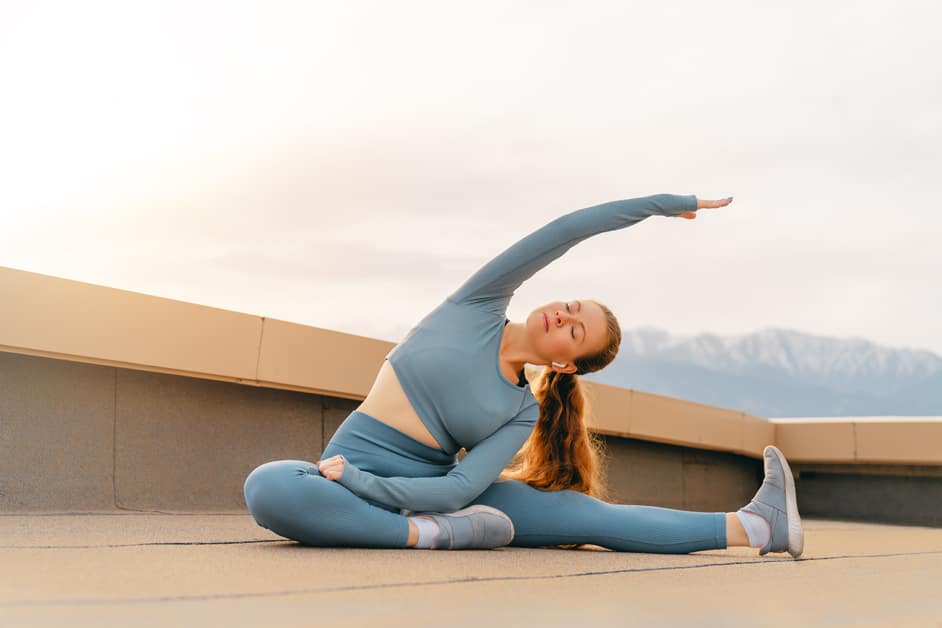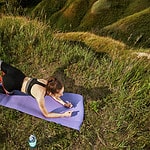Pre-Ride Stretches
Stretching is a must before any ride for avoiding injuries and boosting performance. This is especially true for cycling, so warming up your knees is essential. Here are some simple stretches to do before your ride to prepare your knees: they’ll help you stay safe!
- Quadriceps Stretch: Stand upright, hold your ankle with one hand and pull your foot up towards your buttocks.
- Hamstring Stretch: Sit on the ground with your legs straight out in front of you. Bend one leg and place the sole of your foot against your inner thigh. Lean forward, keeping your back straight.
- Calf Stretch: Stand facing a wall with your hands on the wall and your feet shoulder-width apart. Step one leg back, keeping your heel on the ground and your toes pointing forward. Lean into the wall, keeping your back heel on the ground.
Gluteal stretch
Cyclists should do gluteal stretches. They help with the hip’s range of motion and pedaling power. Plus, they reduce strain on other muscles and lower the risk of injury.
To do a gluteal stretch, lie on your back with both feet on the floor and knees bent. Cross one ankle over the opposite knee. Feel a gentle stretch in the outside of the hip. Hold the leg and pull it towards you until you feel a slight tension in the glutes. Hold for 10-30 seconds and then repeat on the other side. Don’t cause pain— ease up or stop if it does.
Quadriceps stretch
Stretching is an integral part of warming up before cycling. It helps to avoid muscular injuries. Make sure to stretch your quadriceps, as they are a major muscle group used when pedaling.
Face a wall or railing and use it for support if you need. Bring one heel towards the buttocks, alternating legs until both quads have been stretched. With the opposite hand grasp your lower foot, holding it up towards your hips – keep your hips level and body posture unchanged. Hold the position for 20-30 seconds and repeat each hold two more times, applying equal pressure each time. Take a 15 second break in between each stretch.
Hamstring stretch
Achieve full leg movement with a hamstring stretch. This can be done standing or with one leg supported on a higher surface, such as a wall or step.
- Start: Face away from the wall/step. Stand tall with both feet flat on the floor, hip-width apart.
- Action: Step right foot back. Squeeze glutes to keep hips even. Reach forward with both hands. Bend left knee to relax into stretch. Push chest forward, lengthening spine. Tighten stomach muscles. Don’t lose gluteal tension. Hold for 30 secs. Change sides.
- Tips: Keep stomach muscles tight. This supports your lower back. Maintain good form & posture.
Calf stretch
Do the calf stretch before cycling! It loosens and warms up your knees, preventing injury. Stand with feet shoulder-width apart. Bend one front knee, feeling a stretch in the calf muscle of the back leg. Hold 10-15 seconds. Swap legs and repeat. Keep both heels on the ground.
To increase intensity, do heel raises at the end. Press down through heel of one foot and rise onto toes. Lower back down and repeat 8-10 times on each leg. This helps with joint mobility and coordination.
Keep safe while riding!
Pre-Ride Warm-up
Before biking, it’s vital to warm-up your muscles and joints. Knees are especially important! To get ready for biking, do a pre-ride routine that focuses on your knees. This’ll prevent injury and help you perform better.
Here are some exercises for warming up your knees:
Jogging
Before hopping on your bike, warm-up your knees with light jogging. This helps the circulation to your joint, reduces the chance of injury, and preps your body.
Do motions that are comfy. Don’t do high knees or intense running. Start by briskly walking for a few minutes. When you’re done, you should feel warmer.
Do high kicks and full-body stretches, like arm circles and standing side stretches. Don’t overdo it – these exercises prevent injury.
After jogging and stretching, start cycling!
Jumping jacks
Jumping jacks are a great way to get your body ready for cycling. The bouncing and arm flailing stimulates the central nervous system, and increases heart rate and flexibility in the hips, ankles, and calves. Doing a set of jumping jacks before your ride can make you feel ready to go.
If you don’t usually exercise or are new to cycling, try 10-15 jumping jacks as part of your warmup. Make sure to land with both feet together and arms at their side after each jump. This boosts blood flow and loosens tendons and ligaments, reducing your chances of injury while cycling.
After 15 reps, give your body some time to adjust. Then, do
- squats
- lunges
- stretches that target cycling muscles like the neck, chest, shoulders, back, and legs
Warming up with jumping jacks before cycling makes sure your muscles are prepared and reduces the risk of overuse injuries.
Squats
Squats are a must for any warm-up routine. They help build strength in the quads and hamstrings. Plus, they reduce knee pain and post-ride soreness. When doing squats, focus on form.
- Feet shoulder-width apart, toes pointing straight ahead or outward.
- Bend knees and keep back upright.
- Squat until thighs are parallel to floor.
- Carefully stand up using quads.
3 sets of 10 reps, 30 secs rest. Proper form is key. Squats increase strength and reduce injury risk. Plus, they improve range of motion and comfort while riding!
Lunges
Lunges are a great warm-up exercise for cyclists. They help by increasing mobility, flexibility, and stability in the knee joints.
To do a lunge:
- Stand upright with feet hip-distance apart and hands on hips.
- Step one leg forward and lower yourself down. Both knees should be bent at a 90 degree angle.
- The back knee should be nearly touching the ground and the front knee should be above the ankle line.
- Push off your front foot and slowly come up.
- Do 10 repetitions per leg.
To add intensity, hold weights or a bike seat/handlebar.
Active Warm-up
Active warm-ups are a must before any physical activity. They help your body get ready for what’s to come. Cycling isn’t any different. You should always start with an active warm-up routine that focuses on your knees.
This article covers the advantages of active warm-ups and provides some examples of simple exercises for your knees:
Easy spin
Before cycling, it’s important to warm up your knees. An easy spin is a great way to do this. Ride at a low cadence for 3-4 minutes. Then, gradually increase your speed. This will help the blood flow into your tendons and muscles. It can reduce the risk of injury.
For new cyclists, do 2-3 sets of high cadence intervals. Do 30 seconds of 94+ rpm with 30 seconds rest, 4 times during each spin session. Increase duration and strength as your fitness level grows. Add single leg spins or single leg pedaling when beginning each workout. Increase intensity and duration depending on your experience level and goals.
Single-leg pedaling
Single-leg pedaling is a great warm-up for cyclists to reduce the risk of knee injury. It helps with coordination, balance, and range of motion in the knees. Plus, it strengthens the core and hip stabilizers to protect the knees from overuse.
You need a stationary bike to do this exercise. Sit on the bike and hook your feet into the pedals. Make sure your posture is good. Keep your shoulders relaxed and chest lifted.
Raise one leg off its pedal while keeping resistance with the other leg. Lock the other foot in its pedal so it doesn’t move. Pedal in circles for 30 seconds or more with each leg.
Then pedal with both feet for 30 minutes or more. Focus on steady circles and don’t speed up too quickly. When done, decrease speed until the pedals return to resting position. Finally, do 1-2 minutes of stretching focused on cycling muscle groups.
High cadence
High cadence warm-ups mean pedaling faster than usual. This boosts blood flow to the knee joint, helping it get ready for long rides. Do this for several minutes before starting.
To do a high cadence warm-up, pedal at a medium intensity for five minutes. Then, increase your pedal rate to 90-95 RPMs. Keep going for two minutes. After that, return to your normal cadence. Doing this correctly should make sure your knees stay fit and not get injured on long rides.
Standing drills
Standing drills are important for warming up before cycling. They help avoid injury, and improve performance.
Do a few simple drills. Stand straight with feet shoulder-width apart. Point one foot out and push hips back. Hold for 10 seconds, then repeat on other side. Loosen quads, hamstrings, and glutes which support knee joint when biking.
Roll up onto balls of feet, and lunge forward a few inches each side. Return to standing, then do dynamic exercises like lateral lunges and step-ups until warm and ready to ride.
For added stability, focus on single leg drills like squats or calf raises with one foot off floor. Each time you ride, flexibly engage both sides of knee joint:
- Squats
- Calf Raises
Post-Ride Stretches
Stretch those muscles! After a ride, it can reduce the risk of injury and help keep muscles flexible. Post-ride stretches are essential for cyclists to keep bike alignment and reduce discomfort. Warm up your knees before and after cycling. It’s important to avoid cycling-related injuries.
Here’s how:
- Warm up those knees.
- Do post-ride stretches.
IT band stretch
The iliotibial band, also known as the IT Band, is a thick ligament that runs down the side of your thigh. It starts at the hip and ends just below the knee. It helps stabilize and protect your knee.
Stretching it can help stop pain or discomfort in the outer knee joint. Stretching it regularly can also help prevent injuries from physical activities like biking and running.
To stretch the IT band:
- Stand on one leg with a slight bend in the knee.
- Take one arm across your body and grab the elbow. Pull it closer to the chest for a more intense stretch.
- Lean away from your arm and keep proper form (straight back, chest lifted up to the sky).
- Hold for 15-30 seconds, then release slowly. Repeat two more times. Then switch sides.
Piriformis stretch
The piriformis muscle is in the buttocks, beneath the gluteal muscles. It connects to the upper surface of the femur near its neck. This allows the hip to twist on uneven terrain.
Lie flat on your back in a comfortable position. Spread your legs apart as far as possible. Bend your left leg and bring it to rest on top of your right thigh. Clasp your hands around your shin or ankle and gently pull your knee towards your chest. Feel a pulling sensation in the muscle of your right hip and buttocks area. Hold this stretch for 30 seconds. Release your grip and return both feet to the ground. Repeat with the opposite legs for 30 seconds each.
This exercise is important for cyclists. It helps ensure healthy and injury-free knees. That way, they can keep pedaling!
Hip flexor stretch
The hip flexor stretch is a must after a cycling ride. It helps loosen tightness in the hip flexor muscles and can reduce the risk of knee pain while cycling.
- Start standing up straight. Have your feet slightly apart and knees bent. Put one foot slightly in front of you. Keep that leg relaxed. Lean forward from your hips. Hold this pose for 30 seconds or until you feel a mild stretch. Make slight adjustments if needed.
- Switch legs and repeat the process for the other side. After a few reps, slowly increase your range of motion. Adjust as needed based on your tolerance level.
Doing this post-ride routine regularly can help keep knee issues away. And, it can improve performance levels while avoiding injury.
Groin stretch
Remember to stretch after each ride. This will help warm you down and reduce lactic acid in your muscles. It will also improve flexibility and help prevent injuries.
Start with a groin stretch. Sit on the ground with legs in an ‘A’ frame position. Keep your back straight. Slowly bend left knee to chest, feeling a stretch in right hip and thigh. Hold for 30 seconds. Then switch legs. If it’s too easy, progress to a deeper stretch. Use a rod between hands or attach a band to one foot and pull towards you for resistance. Maintain good posture and tension. Relax and don’t hold breath.
Frequently Asked Questions
Q1: What types of exercises should I do to warm-up my knees before cycling?
A1: To warm-up your knees before cycling, you should do dynamic stretches such as leg swings, knee bends, and marching in place. You can also do some light aerobic activity such as jogging or jumping jacks to get your heart rate up.
Q2: How long should I warm-up my knees before cycling?
A2: You should warm-up your knees for at least 5-10 minutes before cycling. This will give your muscles time to loosen up and help prevent injury.
Q3: Are there any specific stretches I should do to warm-up my knees before cycling?
A3: Yes, some specific stretches to do before cycling include leg swings, knee bends, and marching in place. These stretches will help to loosen up your muscles and get them ready for cycling.





